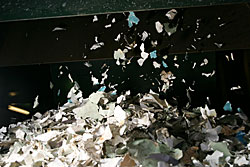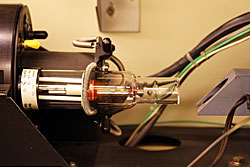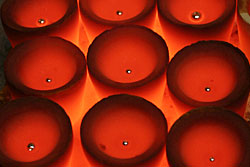The Process – Sampling & Assaying
Sampling and assaying are important key elements of the JBR process.
A fully equipped and versatile sampling department prepares and samples all incoming customer materials.
Incineration, calcination, drying, milling, and melting procedures are utilised to obtain a fully representative quality sample of the lot of material. A final quality sample is assayed in a modern laboratory.
Silver contents are determined for each consignment of material received. The sampling can be witnessed. Assaying is carried out according to classical fire assay techniques and universally accepted chemical methods.
JBR is certified by the LBMA for its assaying capability (refer to Responsible Sourcing Section of the website for the Certificate).
Fire Assaying
The term “fire assay” describes a quantitative procedure in which a fusion is used to separate the precious metals from a known amount of sample. The fusion–or melt–is done in a furnace at high temperatures. This method is the standard for determining gold and silver in ores, concentrates, and a variety of metal alloys.
Fire assay begins with weighing a sample into a crucible and thoroughly blending it with a mixture of dry chemicals. One of the ingredients is lead oxide; another is a reducing agent. The crucible is then placed into a 1000°C furnace. The reducing agent reduces the lead oxide to lead. This forms thousands of small droplets of lead, which collect all the precious metals from the sample and sink to the bottom of the crucible. Meanwhile, the non-precious metal contaminants are carried off into the slag. The crucible is removed from the furnace and poured into a mold. When cool, the slag is discarded and the lead “button” cleaned of any residual slag. This entire process, therefore, selectively collects all the precious metals from the sample and alloys them with lead.
The next step involves a “cupel”. A heated cupel has the unique capability of absorbing metallic oxides. The cupel is preheated to 950°C, the lead button placed into it. The lead melts and the surface oxidizes, the oxide absorbed, exposing more lead, which oxidizes, etc. Since gold and silver do not oxidize, they continue to concentrate until the last of the lead is absorbed; leaving only a bead in the bottom of the cupel. This bead contains all the precious metals from the original sample. It is called the “dore” bead. Its weight is recorded to get the total precious metal content of the sample.
Once the dore is weighed, the silver is dissolved from it with nitric acid–which dissolves silver but does not affect gold. This step is called “parting”. After parting, the weight of gold is recorded. The difference between the dore and the gold is silver.
Platinum Group Metals
The noble metals are analysed more frequently by nickel collection. This technique uses nickel oxide as a collector, and it is possible to determine a range of metals in one procedure, namely platinum, palladium, rhodium, iridium and ruthenium. This method does not use cupellation to separate the collected precious metals, but instead dissolves the pulverized nickel button in acid. The nickel is removed by filtration, the remaining residue of precious metals is treated and the final determination of the solution is made using instrumentation such as ICP.
ICP OES: Inductively Coupled Plasma Optical Emission Spectrometry.
ICP spectrometry analyses solutions of samples of known weights into known volumes by the most appropriate preparation methods for this type of sample. The resulting solution from direct dissolution of the sample or from the parting of the precious metal beads from fire assay is then analysed directly on an ICP spectrometer. The method requires comparative standards and reference samples and has the advantage that it can measure a range of elements sequentially.
ICP spectrometry is an excellent method for measuring PGMs in solution. It is an emission technique, which requires the sample to pass through a nebuliser to create a fine mist. This is then swept into the plasma via a spray chamber and a torch. The plasma itself is a high-energy source that causes the atoms and ions within the sample to absorb energy and reach high energy states, thus giving off energy in the form of light, which is then measured by the spectrometer.








